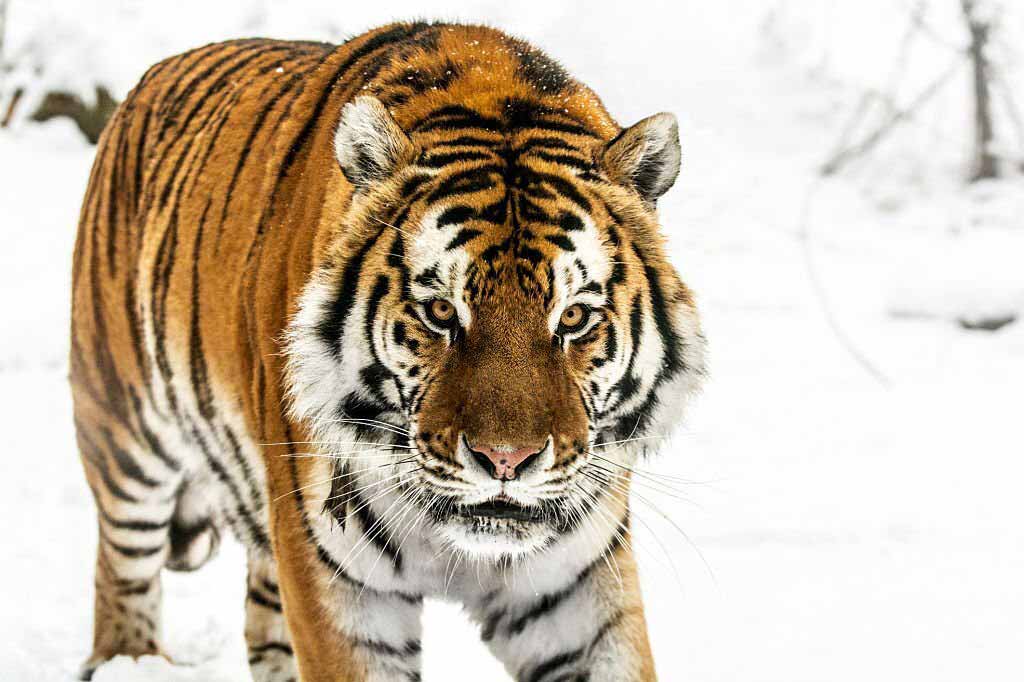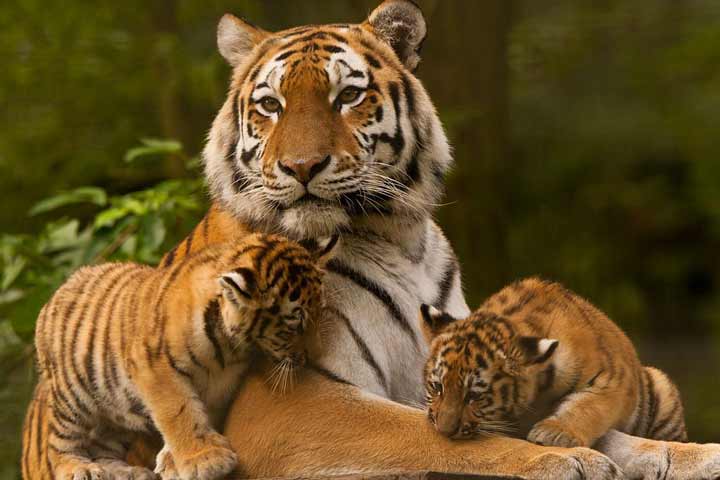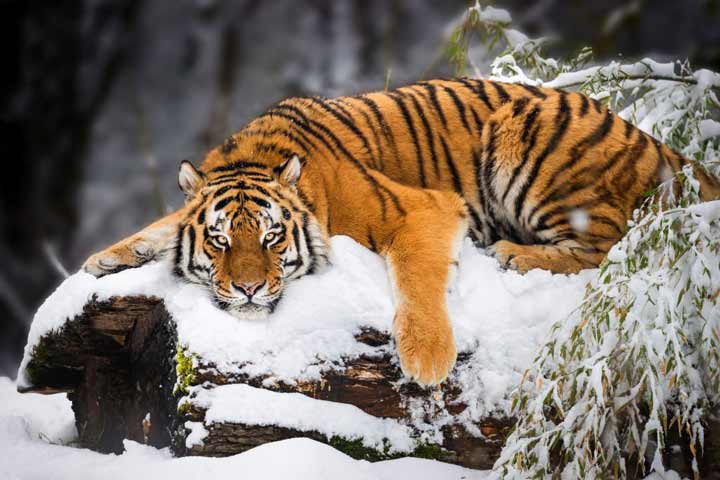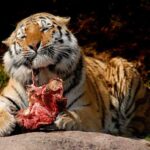The Siberian Tiger, scientifically classified as Panthera tigris tigris, is the largest living cat found in the forests of the Russian Far East, Northeast China, and possibly North Korea. It has many names, such as the Amur tiger, Manchurian tiger, Korean tiger, and Ussurian tiger.
In this article, we will learn about the Siberian Tiger, exploring its characteristics, habitat, behavior, and more.
Quick Overview
| Common Name | Siberian Tiger, Amur Tiger, Korean tiger, and Ussurian tiger |
|---|---|
| Lifespan | 15-18 years in wild, up to 25 years in captivity |
| Diet | Carnivorous (mainly deer, wild boar, cattle, and goats) |
| Weight | 216-300 kg (475-660 lbs) |
| Height | 9 – 13 feet |
| Habitat | Mixed forests, pine forests, and cold climates |
| Population | less than 600 |
| Conservation Status | Endangered |
Taxonomy and Classification
The Siberian tiger was first classified as Felis tigris altaica by Dutch zoologist Koenraad Jacob Temminck in 1844. Over the years, the classification of this tiger has been the subject of debate and study.
In 2017, a significant change occurred when all tiger populations in mainland Asia were grouped under the subspecies P. t. tigris.
Genetic research has revealed a close relationship between the Siberian tiger and the now-extinct Caspian tiger, suggesting that they may have a more recent common ancestor.
| Kingdom | Animalia |
|---|---|
| Phylum | Chordata |
| Class | Mammalia |
| Order | Carnivora |
| Suborder | Feliformia |
| Family | Felidae |
| Genus | Panthera |
| Sub Species | Panthera tigris tigris |
Size

The Siberian tiger is the largest of all tiger subspecies. Males typically weigh between 216-300 kg (475-660 lbs), with average length between 9 – 13 feet while females are generally smaller, weighing between 100 – 170 kg.
The fur is reddish-rusty or rusty-yellow, adorned with narrow black stripes that provide camouflage in their forest habitat. The winter fur is particularly dense, long, and silky, providing necessary insulation against the cold.
The skull is characterized by its large size, with males having a maximum length ranging from 331 to 383 mm and females from 279.7 to 310.2 mm. These dimensions reflect the tiger’s powerful bite force, essential for its predatory lifestyle.
The Siberian tiger’s physical attributes, including its impressive canines, strong limbs, and unique coat pattern, are not just symbols of beauty but functional adaptations that have enabled it to survive and thrive in some of the harshest and most rugged terrains on Earth.
Distribution and Habitat

The Siberian tiger’s current range is confined to the Russian Far East, particularly in the Sikhote-Alin mountain region and parts of Northeast China. Historically, they were found across the Korean Peninsula and other parts of northeastern China.
They inhabit mixed forests, where Korean pine is a key species, providing both shelter and food sources. The habitat is characterized by dense forests, rugged terrains, and cold climates, all of which the Siberian tiger has adapted to thrive in.
Behavior

Siberian tigers are solitary and territorial creatures, marking their territory with scent markings. They can travel vast distances for food, covering up to 1,000 km. Their nocturnal behavior and preference for dense forests make them elusive and challenging to study.
Social interactions are limited to mating and caring for young cubs. Vocalizations, body language, and scent markings are essential for communication among these tigers.
Hunting and Diet
The Siberian tiger’s diet is diverse, including large ungulates like wapiti, moose, wild boar, and even Asiatic black and brown bears. They are ambush predators, using their stripes as camouflage to stalk their prey.
A single powerful bite is often enough to take down large prey. The hunting success rate is estimated to be around 10%, and they may go several days without a meal.
Interspecific Predatory Relationships

These tigers have complex relationships with other predators. They are known to attack Ussuri brown and black bears, often during the bears’ hibernation period. Conversely, there have been instances of larger brown bears attacking and killing tigers.
These interactions reflect the complex dynamics of the food chain and competition for resources in their shared habitat.
Reproduction and Life Cycle

Mating occurs in the winter, and after a gestation period of about 3.5 months, the female gives birth to a litter of 2-4 cubs.
The cubs are born blind and rely entirely on their mother for the first few months. They are weaned at around six months but remain with the mother for up to two years, learning essential survival skills.
The mortality rate for cubs is high, with only about half surviving to adulthood.
The Siberian tigers have a lifespan of 15-18 years in the wild(up to 25 years in captivity).
Conservation Efforts
The Siberian tiger population has faced severe threats from habitat loss, poaching, and prey depletion. Intensive conservation efforts have stabilized the population, including anti-poaching measures and habitat restoration.
The Russian government has implemented various protection measures in collaboration with international organizations.
Today there are only less than 600 individuals left. And the species is still classified as Endangered, and continuous efforts are required to ensure its survival.
Facts About Siberian Tiger
- Largest Subspecies: The Siberian tiger is the largest of all tiger subspecies.
- Cold Climate Adaptation: They have a thick layer of fat and dense fur to protect against the harsh cold climates of Russia and parts of China.
- Natural Snowshoes: Their large, furry paws act like snowshoes, helping them navigate deep snow.
- Territory: A male Siberian tiger can have a territory of up to 1,000 square kilometers.
Conclusion
The Siberian Tiger’s presence in the wild is a delicate blend of strength, adaptability, and fragility. This extraordinary creature’s distinct characteristics, behaviors, and the obstacles it encounters reflect the multifaceted and astonishing aspects of nature.
The future of this remarkable species relies on our collective comprehension, reverence, and commitment to conserving its natural environment and lifestyle.
As a symbol of the wilderness’s grandeur, the Siberian Tiger emphasizes our duty to protect and cherish these awe-inspiring beings, ensuring their legacy endures.
FAQs
The Siberian Tiger is native to the Russian Far East, Northeast China, and possibly North Korea.
They primarily feed on large ungulates like wapiti, moose, wild boar, and even Asiatic black and brown bears.
Males typically weigh between 216-300 kg, with an average length of 9 – 13 feet, while females weigh between 100 – 170 kg.
As of now, there are less than 600 individuals left in the wild.
Adult Siberian Tigers have a lifespan of 15-18 years in the wild and up to 25 years in captivity.
Yes, the Siberian Tiger is classified as Endangered, and continuous efforts are required to ensure its survival.




